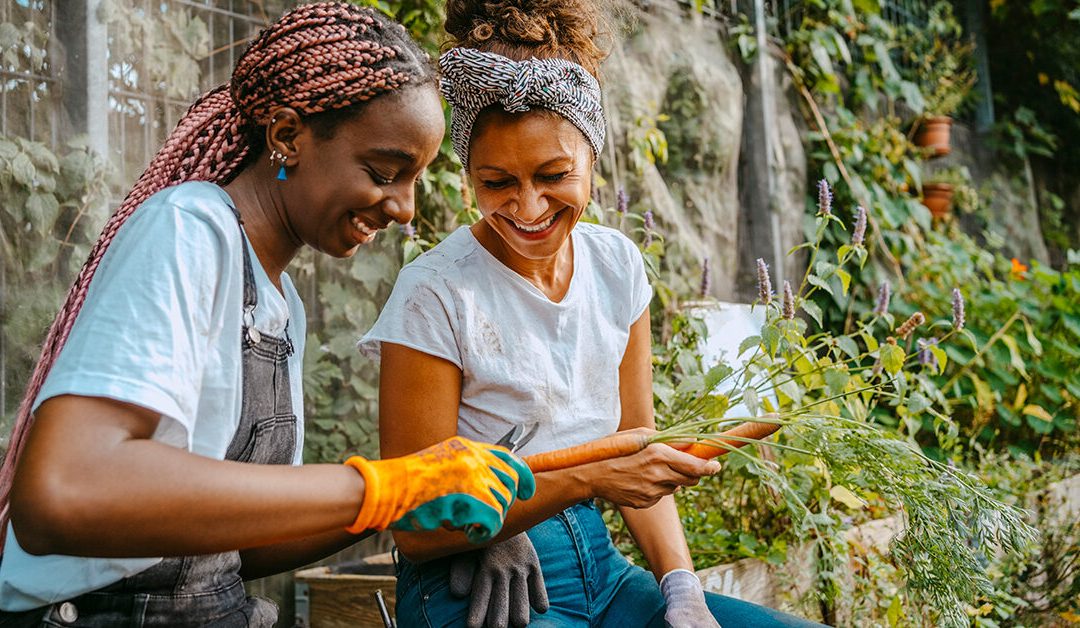These statistics are disheartening, but countless organizations have hit the ground running with the goal of reaching food justice.
They tackle the issue of food inequity through work that focuses on:
Feeding families
Both the Learning Gardens’ Rose and Nina Womack of Los Angeles’ Let’s Be Whole said that today, rising food prices affecting low-income families make the pursuit of food justice even more vital.
Food accessibility has long been an issue, but the current rate of inflation has made groceries more expensive than ever.
Rose shared that the Learning Gardens she leads are home to food crops, yielding fresh food for local community members, free of charge.
During peak growing season, Rose says the gardens can grow thousands of pounds of food that get distributed to both the youth in our programs and their families, providing the opportunity to both feed and educate communities simultaneously.
Another organization focusing on feeding communities is the Oyate Group of New York.
The Oyate Group offers varied initiatives that focus on poverty alleviation within their community, centering food justice through their partnership with GrowNYC.
Since the fall of 2021, in addition to leading community events, the collaboration has provided fresh food to more than 500 families.
Jason Autar, chief operating officer of Oyate Group, said that the organization only plans to scale up from here, citing the importance of continued direct collaboration with community members.
Mitigating the lack of transportation access
In addition to the rising cost of ingredients, because food apartheid is the intentional racial and socioeconomic segregation of food-based resources by neighborhood, transportation is a major barrier to access.
Communities are separated, limiting the grocery stores (especially those that are high-end and selling primarily organic ingredients) to the wealthier parts of a town, which are often dominated by white individuals.
This bars folks who don’t have vehicles, who have hectic shift-based work schedules, or face issues accessing childcare from reaching these stores and their high-quality ingredients.
When grocery stores are inaccessible to a community, its residents often rely on convenience stores for food, which generally sell more expensive products with less nutritional value. Research suggests that this contributes to racial health disparities.
Womack from Let’s Be Whole pushes for food justice by bringing food directly to the South L.A. community.
She uses her experiences with hunger and poverty to create a health food business that doubles as a mobile food pantry.
“As a wellness and food relief organization, we bring the food to the people and eliminate the need to have a permanent building in order to be able to give out food confined to just one area,” Womack told Healthline.
Expanding education
According to Rose, the Learning Gardens program — originally called Growing Gardens — was created in 1997 in an effort to transform failing public schools and revitalize underserved neighborhoods through a partnership between City Parks Foundation and the New York City Department of Education.
In 2004, the program became Learning Gardens, which now rehabilitates neglected plots throughout the city, turning them into beautiful community gardens and sites for immersive, outdoor learning.
An aspect that sets Learning Gardens apart is the program’s dedication to centering the community’s youth.
Many young folks of color — particularly those from low-income communities — don’t have the opportunity to consider land ownership as a possibility for their futures.
The initiative takes a “yes, and” approach, combining the necessity of feeding families right now with the education to continue agricultural practices long-term.
“I’ve found that educational programs are most effective, especially in having the inclusion of urban farming in our community gardens that allow youth to be at the forefront,” Rose said.
Meeting people where they are is vital, but it doesn’t mean that you can’t also introduce new techniques and foods.
The Learning Gardens leader emphasized the importance of acknowledging about the impact of poverty cycles.
“If you want people to eat better, you have to educate without talking down,” Rose said.
— Shari Rose, associate director of environmental education at City Parks Foundation and leader of the Learning Gardens program in New York
Addressing racial disparities with representation
When it comes to trust-building and effective change, it’s important to have the opportunity to engage with folks who look like you.
That’s especially true when we think about systemic issues like food insecurity, where BIPOC folks are most vulnerable to the impact — yet are pushed out of the larger-scale conversations surrounding solutions.
Autar said that the Oyate Group addresses this problem not only through their BIPOC leadership team, but also by providing resources directly into the hands of the community.
With their goal of avoiding overcomplicated bureaucracy, they aim to directly serve the most vulnerable of their community.
Autar referenced the stark racial disparities within New York City food insecurity, especially in much of the South Bronx. He said these areas are effectively void of healthy food options.
“This is very representative of what communities experience the highest rates of food insecurity and food deserts,” he said.
Rose’s Learning Gardens program is also BIPOC-led, intentionally reflecting the communities they serve and teach within.
In addition to the students, the program also teaches in five gardens in predominantly BIPOC, under-resourced neighborhoods.
“The program ultimately connects students to their families and cultural roots, empowering them to fight food insecurity and making the program a powerful, on-the-ground tool in the fight for a more just food system,” Rose says.
Addressing exploitation of farm workers of color
The racial disparities are also present for workers of color within the agricultural field, particularly those who are Indigenous or undocumented.
They’re often exploited through long hours, poor treatment, low compensation, and little to no benefits.
This means that often, white individuals with higher incomes are the ones able to regularly afford fresh ingredients, while People of Color are blamed for what are considered poorer dietary choices — all while BIPOC farm workers are overlooked and underpaid.
Achieving food justice has to include addressing this issue not only through increased widespread access to food, but significantly improved conditions for the folks that make the food possible.
Community and urban gardening
Rose encourages students in the New York City area to get involved in the Learning Gardens program to learn skills that you can take back to your community or to start a garden if you don’t have one near you.
“Food justice is about regaining access to healthy, culturally appropriate food for all, so spreading the wealth of knowledge is essential,” she said.
Learning Gardens’ leadership wants youth to feel empowered by the practices of farming and gardening, particularly because BIPOC folks have been excluded from those conversations.
“Education is a precursor to food sovereignty,” Rose said, speaking to the history of BIPOC exclusion in white-dominated spaces.
“It’s time to fix our broken food systems,” Womack said. “If community-based, urban agricultural initiatives worked back in the day, then surely they can work again now.”
— Esperanza Pallana, executive director of Food and Farm Communications Fund
Amplification and funding
Another avenue is supporting and uplifting the work already being done.
Food and Farm Communications Fund pushes towards a more equitable world through financially supporting agriculturally-focused organizations’ communications programming, as well as shifting the media narrative around food and access.
“I want that our food media is transformed away from a culturally homogenous landscape and that there is no longer a dominant narrative that the industrialized food (and agriculture) system is efficient and the harm it causes is necessary to feed the world,” Esperanza Pallana, executive director of the fund, told Healthline.
Pallana says that participation in this network has not only aided partners in lessening the isolation that can occur with agricultural work, but has even connected them to folks to expand their work.
This proved especially helpful during the height of the COVID-19 pandemic in 2020 amid restaurant closings and contract changes.
“Many small producers are blocked out of big contracts, so they sell to smaller independent grocers and restaurants,” she said. “With restaurant closure in 2020, those farmers operating in networks were able to redirect their produce to projects ensuring populations particularly vulnerable to the effects of COVID were food secure.”
Reducing food waste
A staggering amount of food that’s procured doesn’t get sold, and instead gets marked for the garbage.
Part of Let’s Be Whole’s work includes food recovery from places like food banks, grocery stores, and farmer’s markets.
That way, instead of being wasted, they’re given to low-income community members for free.
“People appreciate the Let’s Be Whole mobile food pantry because we offer primarily organic, prepared foods and produce from grocery stores such as Whole Foods and Trader Joe’s, as well as lots of fruits and vegetables from local farm organizations or farmer’s markets,” Womack said.
This content was originally published here.

